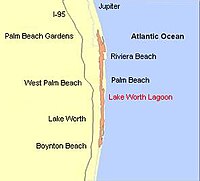
Photo from wikipedia
Abstract Coastal water bodies are impacted by watershed alterations, increased population density, modifications to inlets and shorelines, climatic periodicity, and increases in external material loads. Estuaries such as Lake Worth… Click to show full abstract
Abstract Coastal water bodies are impacted by watershed alterations, increased population density, modifications to inlets and shorelines, climatic periodicity, and increases in external material loads. Estuaries such as Lake Worth Lagoon (LWL) in south Florida possess all these attributes. The LWL watershed extends from the southeastern portion of Lake Okeechobee through Palm Beach County, where it meets the lagoon. Palm Beach County Department of Environmental Resources Management recognizes the social and ecological importance of the ~36 km lagoon and aims to maintain suitable water and habitat quality for all stakeholders. Recent declines and shifts of seagrass distribution along the lagoon prompted a step toward better understanding the water quality patterns of the system. In support of these efforts, this study assessed bathymetry, inflow, flushing, and water quality attributes (chlorophyll a, salinity, total nitrogen, total phosphorus, total suspended solids, turbidity) using data collected along a series of 14 midlagoon stations from 2007 to 2015. Salinity in the North Segment was higher and less variable because of proximity to Palm Beach Inlet. Although concentrations of chlorophyll a, total nitrogen, and total phosphorus correlated with freshwater inflow, turbidity and total suspended solids were not. Fast flushing of the lagoon on a scale of days likely precludes water quality issues common to many estuaries with higher resident times. However, the combination of landscape-scale water management, a shoreline that is almost 70% modified by hard structures, and changes in essential nearshore habitats, introduces new levels of uncertainty to both the understanding and management of LWL. From this study, increased knowledge of relationships among water quality parameters and their spatial and temporal variability in LWL provides points of reference from which targeted studies can be developed to explore links between environmental parameters and responses of key organisms in this unique system.
Journal Title: Marine Technology Society Journal
Year Published: 2018
Link to full text (if available)
Share on Social Media: Sign Up to like & get
recommendations!